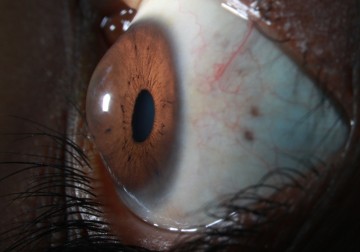In a new study from LVPEI, Drs. Pravin K. Vaddavalli, Rashmi S. Deshmukh, Anthony V. Das, and others describe the clinical presentation and demographic distribution of keratoconus among LVPEI’s patients.
Keratoconus is a deformation of the dome-like ocular surface that manifests in young people, often teenagers. The condition is characterized by a gradual thinning of the cornea, causing it to bend out of shape. If left untreated, keratoconus can lead to severe vision impairment. Keratoconus has a male preponderance and onsets around puberty, progressing for a decade or so. This hampers the education and career prospects at a very productive period in a person’s life. Visual acuity is restored with contact lens or spectacles, though some may need surgery to shore up the corneal structure. While the development and management of keratoconus is well-known, our understanding of its etiology and prevalence in a population has many gaps.
There seems to be a great variation in the prevalence of keratoconus around the world. A study from the Netherlands found a prevalence of 2.65% in the general population, while a study from central India found a 2.3% prevalence in a small, rural population. However, a fifty-year study in the US found a 5.4% prevalence. A UK-based study that looked at a mixed population, found that people of Asian origin had a significantly higher rate of prevalence (1:4000 vs 1:30,000) and the condition presented sooner among them. So, any new data can only add to our understanding of this condition and clarify key aspects of its presentation in the population.
In a new cross‑sectional, observational hospital‑based study published in the Indian Journal of Ophthalmology, Drs. Pravin K. Vaddavalli, Rashmi S. Deshmukh, Anthony V. Das, and others from LVPEI have added to our understanding of keratoconus. They describe the clinical presentation and demographic distribution of keratoconus patients from four Indian states at LVPEI’s hospitals. The study included 2,384,523 patients, who underwent comprehensive ophthalmic examinations at LVPEI, over an 8-year period. Among them, 14,749 patients had keratoconus, putting the hospital-based prevalence at 0.62%.
More male patients (61%) had keratoconus. In fact, men were eight times more susceptible to keratoconus than women. The highest prevalence of keratoconus (2.4%) was seen among patients in their 20s (median: 22 years) with a likely onset earlier in their life. Most patients (89%) were from middle class families. Upper middle-class youths were five times more susceptible to keratoconus than those of lower socioeconomic strata. Almost half of the patients (48%) were prescribed corrective contact lenses to manage the disease. Only 10% of the patients required surgical interventions, like collagen cross-linking.
‘This is the first big-data study on the profile of keratoconus patients in India giving us an insight into the presentation of this disease in our population,’ concludes Dr. Rashmi Deshmukh, Consultant Ophthalmologist at LVPEI and the first author of this paper.
Citation
Das AV, Deshmukh RS, Reddy JC, et al. Keratoconus in India: Clinical presentation and demographic distribution based on big data analytics. Indian J Ophthalmol. 2024;72(1):105-110
Photo credit: Keratoconus; by Kiranmayi, LVPEI



